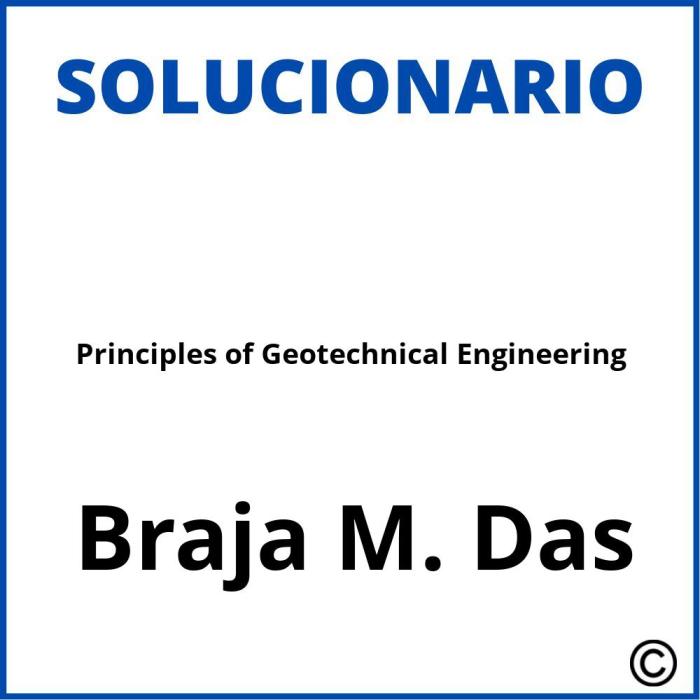The principles of geotechnical engineering 10th edition pdf is an indispensable resource for students, practitioners, and researchers in the field of geotechnical engineering. This comprehensive textbook provides a thorough understanding of the fundamental principles and applications of geotechnical engineering, equipping readers with the knowledge and skills necessary to design and analyze geotechnical structures and systems.
This 10th edition has been extensively updated and revised to reflect the latest advancements in the field, including new chapters on sustainability and numerical modeling. With its clear and concise explanations, illustrative examples, and end-of-chapter problems, this textbook is an essential reference for anyone seeking to gain a deep understanding of geotechnical engineering.
1. Introduction to Geotechnical Engineering

Geotechnical engineering is the branch of civil engineering concerned with the behavior of earth materials and their interaction with structures. It is a highly specialized field that requires a thorough understanding of soil mechanics, foundation engineering, earth retaining structures, ground improvement techniques, and geotechnical investigations and testing.
Geotechnical engineers are responsible for designing and constructing foundations for buildings, bridges, and other structures, as well as for designing and constructing earth retaining structures such as retaining walls and embankments. They also play a vital role in the design and construction of tunnels, dams, and other underground structures.
Scope and Applications of Geotechnical Engineering
- Design and construction of foundations for buildings, bridges, and other structures
- Design and construction of earth retaining structures such as retaining walls and embankments
- Design and construction of tunnels, dams, and other underground structures
- Evaluation of soil and rock properties for engineering purposes
- Development of new and innovative geotechnical engineering techniques
2. Soil Mechanics

Soil mechanics is the study of the behavior of soil under the action of loads. It is a fundamental discipline in geotechnical engineering, as it provides the basis for the design and construction of foundations, earth retaining structures, and other geotechnical structures.
Basic Properties of Soil
- Grain size distribution
- Density
- Porosity
- Water content
- Compressibility
- Shear strength
Soil Classification Systems
Soil classification systems are used to group soils into different categories based on their properties. The most common soil classification systems are the Unified Soil Classification System (USCS) and the American Association of State Highway and Transportation Officials (AASHTO) soil classification system.
Soil Behavior Under Different Loading Conditions
Soil behavior under different loading conditions is a complex topic that is studied in detail in soil mechanics. The most common types of loading conditions that are considered in geotechnical engineering are:
- Static loading
- Dynamic loading
- Cyclic loading
3. Foundation Engineering
Foundation engineering is the branch of geotechnical engineering concerned with the design and construction of foundations for buildings, bridges, and other structures.
Design and Analysis of Shallow Foundations
Shallow foundations are foundations that are constructed near the surface of the ground. The most common types of shallow foundations are footings and rafts.
Design and Analysis of Deep Foundations
Deep foundations are foundations that are constructed below the surface of the ground. The most common types of deep foundations are piles and caissons.
Evaluation of Soil-Structure Interaction
Soil-structure interaction is the interaction between a structure and the soil that supports it. It is an important consideration in the design of foundations, as it can affect the stability and performance of the structure.
4. Earth Retaining Structures: Principles Of Geotechnical Engineering 10th Edition Pdf
Earth retaining structures are structures that are used to retain soil or rock. The most common types of earth retaining structures are retaining walls, gravity walls, cantilever walls, and sheet pile walls.
Design and Analysis of Retaining Walls
Retaining walls are structures that are used to retain soil or rock on one side. They are typically constructed of concrete, masonry, or steel.
Slope Stability Analysis and Mitigation Measures
Slope stability analysis is the study of the stability of slopes. It is important to evaluate the stability of slopes in order to prevent landslides and other slope failures.
5. Ground Improvement Techniques
Ground improvement techniques are techniques that are used to improve the properties of soil or rock. The most common ground improvement techniques are compaction, grouting, and soil nailing.
Description of Various Ground Improvement Techniques
- Compaction
- Grouting
- Soil nailing
- Jet grouting
- Vibro-compaction
Analysis of the Effectiveness and Applications of Each Technique
The effectiveness of a ground improvement technique depends on the soil conditions and the desired improvement. It is important to select the appropriate ground improvement technique for the specific project.
6. Geotechnical Investigations and Testing
Geotechnical investigations and testing are essential for the design and construction of geotechnical structures. Geotechnical investigations are used to determine the properties of soil and rock at a site, and geotechnical testing is used to evaluate the strength and behavior of soil and rock samples.
Planning and Conducting Geotechnical Investigations, Principles of geotechnical engineering 10th edition pdf
Geotechnical investigations are typically conducted in three phases:
- Preliminary investigation
- Detailed investigation
- Construction monitoring
Description of Common Soil Testing Methods and Their Interpretation
The most common soil testing methods are:
- Standard penetration test (SPT)
- Cone penetration test (CPT)
- Shear strength test
- Consolidation test
Analysis of Geotechnical Data for Design Purposes
Geotechnical data is used to design geotechnical structures. The data is used to determine the bearing capacity of the soil, the settlement of the structure, and the stability of the structure.
7. Numerical Modeling in Geotechnical Engineering
Numerical modeling is a powerful tool that can be used to analyze geotechnical problems. Numerical models can be used to simulate the behavior of soil and rock under different loading conditions, and they can be used to evaluate the performance of geotechnical structures.
Explanation of the Principles of Numerical Modeling
Numerical modeling is based on the finite element method or the finite difference method. These methods divide the soil or rock into a series of small elements, and they then solve the governing equations of soil mechanics for each element.
Demonstration of the Use of Numerical Modeling in Geotechnical Analysis
Numerical modeling can be used to analyze a wide variety of geotechnical problems, including:
- Settlement of foundations
- Stability of slopes
- Flow of groundwater
- Seismic response of soil and rock
8. Sustainability in Geotechnical Engineering
Sustainability is an important consideration in geotechnical engineering. Geotechnical engineers can help to reduce the environmental impact of their projects by using sustainable materials and construction methods, and by designing structures that are energy-efficient and resilient to climate change.
Discussion of the Environmental Impact of Geotechnical Projects
Geotechnical projects can have a significant environmental impact. The construction of foundations, earth retaining structures, and other geotechnical structures can disturb the soil and rock, and it can also pollute the air and water.
Exploration of Sustainable Practices in Geotechnical Design and Construction
Geotechnical engineers can use a variety of sustainable practices to reduce the environmental impact of their projects. These practices include:
- Using recycled materials
- Minimizing the use of energy and water
- Designing structures that are resilient to climate change
Frequently Asked Questions
What are the main topics covered in the principles of geotechnical engineering 10th edition pdf?
The main topics covered in the principles of geotechnical engineering 10th edition pdf include:
- Introduction to geotechnical engineering
- Soil mechanics
- Foundation engineering
- Earth retaining structures
- Ground improvement techniques
- Geotechnical investigations and testing
- Numerical modeling in geotechnical engineering
- Sustainability in geotechnical engineering
Who is the target audience for the principles of geotechnical engineering 10th edition pdf?
The principles of geotechnical engineering 10th edition pdf is intended for students, practitioners, and researchers in the field of geotechnical engineering. It is an essential reference for anyone seeking to gain a deep understanding of the fundamental principles and applications of geotechnical engineering.
What are the key features of the principles of geotechnical engineering 10th edition pdf?
The key features of the principles of geotechnical engineering 10th edition pdf include:
- Clear and concise explanations
- Illustrative examples
- End-of-chapter problems
- Updated content
- New chapters on sustainability and numerical modeling